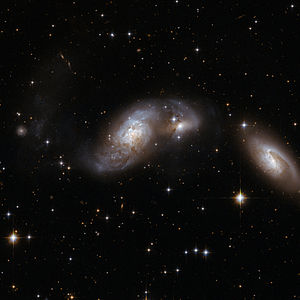IC 4687
| Galaxy IC 4687 |
|
|---|---|

|
|
| The galaxies IC 4687 (center), IC 4686 (right of center) and IC 4689 (right edge of the image) recorded by the Hubble space telescope | |
| AladinLite | |
| Constellation | peacock |
|
Position equinox : J2000.0 , epoch : J2000.0 |
|
| Right ascension | 18 h 13 m 39.6 s |
| declination | -57 ° 43 ′ 31 ″ |
| Appearance | |
| Morphological type | Sd HII |
| Brightness (visual) | 13.5 likes |
| Brightness (B-band) | 14.3 mag |
| Angular expansion | 0.9 ′ × 0.5 ′ |
| Position angle | 54 ° |
| Surface brightness | 12.5 mag / arcmin² |
| Physical data | |
| Affiliation | LGG 418 |
| Redshift | 0.017345 ± 0.000033 |
| Radial velocity | 5200 ± 10 km / s |
|
Stroke distance v rad / H 0 |
(229 ± 16) x 10 6 ly (70.1 ± 4.9) Mpc |
| history | |
| discovery | Royal Harwood Frost |
| Discovery date | August 1, 1904 |
| Catalog names | |
| IC 4687 • PGC 61602 • ESO 140-10 • IRAS 18093-5744 • 2MASX J18133982-5743312 • SGC 180920-5744.4 • FAIR 45 • AM 1809-574 | |
IC 4687 is a spiral galaxy of the Hubble type Sb in the constellation Peacock in the southern sky . It is about 229 million light years away from the Milky Way and has a diameter of about 70,000 light years , including the extended northern extension about 100,000 light years .
IC 4687, together with IC 4686 and IC 4689, forms an interacting galaxy trio.
The galaxy IC 4687 was discovered on August 1, 1904 by the American astronomer Royal Harwood Frost .
Web links
Commons : IC 4687 - Collection of Images, Videos and Audio Files
Individual evidence
- ↑ a b c d NASA / IPAC EXTRAGALACTIC DATABASE
- ↑ a b c d e SEDS : IC 4687
- ↑ Seligman . Retrieved August 2, 2017.
Attention: The sorting key “IC 4687” overwrites the previously used key “IC4687”.
